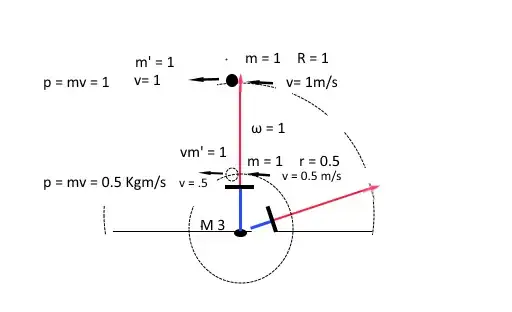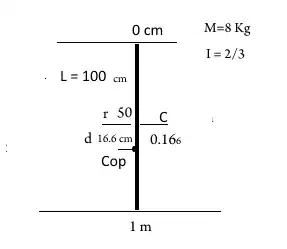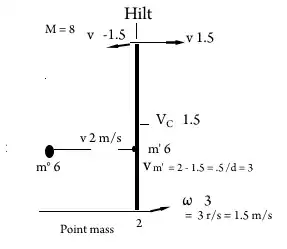TL;DR:
If you have to choose either "near the handle" or "near the tip", the tip will work better. But there's a point in between these two that works even better; exactly where that point is depends on how you swing the sword, and how its weight is distributed.
UPDATED now I am near a computer and can draw diagrams etc.
If cutting off the zombie's head is an inelastic collision that requires the greatest transfer of momentum/energy, then clearly this will be achieved if the sword stops moving completely at the end of the stroke - if the sword keeps moving it still has energy / momentum that wasn't used to chop off the head.
This is achieved when you hit at the center of percussion: the point along the sword where you would feel no "twang" when you hit (on sports equipment like bats and rackets they call it the "sweet spot").
The exact location of the center of percussion depends on the geometry of the sword. Many medieval swords had a heavy pommel - not only to make it harder for the sword to slip from your hand, but also to increase the moment of inertia and thus move the center of percussion (the center of rotation of a sword is typically not the end - if you "flick the wrist" it will be inside the sword, while a broad swing from the shoulders with straight arms might move it further back).
It is conceivable you can put the center of percussion at the tip of the sword - this happens when you swing the sword (assuming it is a uniform rod) about a point that is $\frac13$rd of the way along the length. The point can be moved by changing the weight distribution. However, if you swing from the shoulders, the tip is not the most effective place for momentum transfer.
Some more details:
First - the motion of a rod when struck. The following diagram is helpful:
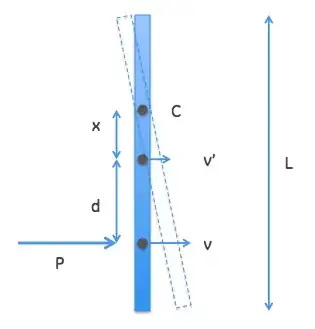
If we strike any rod (length $L$) with an impulse $P$ at a distance $d$ below the center of mass, then the rod will move in such a way that the point $C$ will initially not move - in other words we get rotation about $C$. This is true regardless of the mass distribution of the rod - only the position of C will change. Conservation of angular momentum about the center of mass gives
$$Pd = I\omega\tag1$$
and for rotation about $C$ we can write
$$P(x+d) = (I+mx^2)\omega\tag2$$
It follows that
$$Px = mx^2\omega$$
$$P = mx\omega\tag3$$
Combining (1) and (3) we get
$$mxd = I$$
and we know that for a uniform rod, $I=\frac{mL^2}{12}$. Thus, when the rod is struck at the end, $d=\frac{L}{2}$ and solving for $x$ we find that the center of percussion $C$ is found at a point that is $\frac{L}{6}$ above the center of mass.
The same analysis can be used in reverse: if I rotate the rod about point $C$, then it will come to a complete stop if we hit it at a point that is $d$ from the center of mass. Now why would that give the greatest impact?
Remember that the center of mass of an object moves as though all the forces acting on the object act at the center of mass - so if we look at the motion of the center of mass before and after the impact, we can determine what the sum of external forces was. For the purpose of the analysis, I am assuming that the force of the hand on the sword during the moment of impact is small compared to the force of the swing - in other words, if I just spent a second getting my sword up to zombie-head-cutting speed, the additional force I can provide during the moment of impact is small. If you don't neglect that, the answer can change.
Here are two scenarios - hitting just above, or just below, the center of percussion:
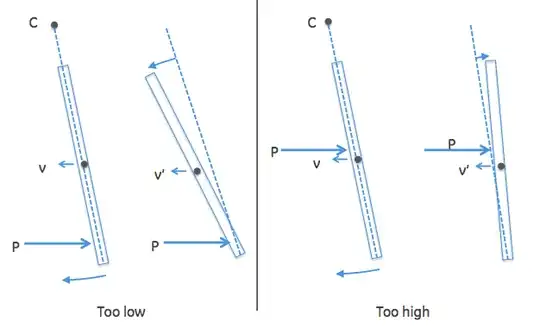
As you can see, in either case the center of mass continues in the original direction, although with reduced speed. This shows that the total impact $P=m\Delta v$ is less than if the impact was exactly at the center of percussion (which would have resulted in no rotation after the impact).
In this drawing I put the center of rotation $C$ outside of the sword - a good swing with a broadsword capable of zombie-killing probably requires full body engagement with hips and shoulders; in that scenario the distance $x$ becomes large, and $d$ has to be smaller. The further away the point of rotation, the more you want to strike close to the center of mass - the product remaining constant. In the case of a uniform mass distribution the relationship is
$$xd = \frac{L^2}{12}$$
But regardless of the shape of the sword, when you double the distance to the point of rotation you halve the distance to the center of percussion.
There is a nice demo of various objects being sliced in slow motion with a Katana that you can see on YouTube.
A still shot from the "pork chop" slicing - which they claim is the most realistic simulation of a human - is shown here:
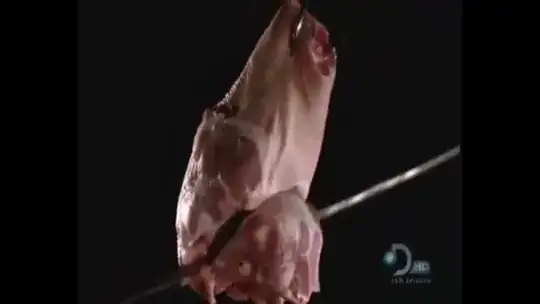
While you can't see the whole blade in this frame, it looks to me that the point of impact is closer to the center of the blade than to the tip - just as you would expect if you are trying to hit near the center of percussion, and the sword is rotating about a point near the hilt or beyond.
Note that the katana doesn't just "push" but, because of the angle, also "slices" - it pulls as it strikes so there is a cutting motion. But the image clearly shows that the person handling the sword chooses a point inside (not the tip) to make the cut. This agrees with the above analysis.
One final note: if you hit with a point beyond the center of percussion there is a reaction force on your hands that makes you pull back on the blade - the force is away from the direction of the strike. And if some of the deceleration of the blade is provided by the hands, the momentum imparted to the zombie is less.
If the point of impact is inside the CoP, holding the blade still would require a force in the direction of the impact, and could theoretically result in greater transfer of momentum.
However, the time of impact is very short - if you assume that you moved the blade through a 120 degree arc, and the 15 cm neck of the zombie at a distance of 1 m represents an arc of 0.15 rad $\approx$ 10 degrees, then the time during which you could apply additional force (increase momentum of the sword) is at most 10% of the time of your swing - and so a very small correction (assuming you were using all your strength to swing the blade to begin with).
A final point - when a katana is used to injure an opponent (rather than sever the head) in battle the fighter will typically use the blade at an angle and slice with just the tip (5 cm). This does not provide the greatest transfer of momentum but rather ensures that the blade will not get stuck (as the center of mass keeps moving it will counter rotate the blade and pull it out). This means that the fighter can continue the arc, keep control of the blade, and have it ready for a next blow - either to attack or defend. But here we are taking about a single death blow - so this reasoning does not hold.



